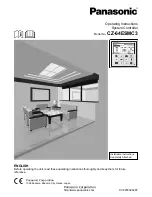
71
VersiStart i III
14.
Busbar Adjustment Procedure
The busbars on non-bypassed models VS i III 360N ~ VS i III 1600N can be adjusted for top or bottom input and output as required.
NOTE
Many electronic components are sensitive to static electricity. Voltages so low that they cannot be felt, seen or heard, can
reduce the life, affect performance, or completely destroy sensitive electronic components. When performing service,
proper ESD equipment should be used to prevent possible damage from occurring.
All units are manufactured with input and output busbars at the bottom of the unit as standard. The input and/or output busbars can be
moved to the top of the unit if required.
09275.
B
1.
Remove all wiring and links from the soft starter before
dismantling the unit.
2.
Remove the unit cover (4 screws).
3.
Remove the keypad faceplate, then gently remove the
keypad (2 screws).
4.
Remove the control terminal plugs.
5.
Gently fold the main plastic away from the starter (12
screws).
6.
Unplug the keypad loom from CON 1 (see note).
7.
Label each SCR firing loom with the number of the
corresponding terminal on the backplane PCB, then unplug
the looms.
8.
Unplug the thermistor, fan and current transformer wires
from the model board.
9.
Remove the plastic tray from the starter (four screws).
NOTE
Remove the main plastic slowly to avoid damaging the keypad wiring loom which runs between the main plastic and the
backplane PCB.
08605.
A
10.
Unscrew and remove the magnetic bypass plates (models
VS i III 620N to VS i III 1600N only).
11.
Remove the current transformer assembly (three screws).
12.
Identify which busbars are to be moved. Remove the bolts
holding these busbars in place then slide the busbars out
through the bottom of the starter (four bolts per busbar).
08606.
A
13.
Slide the busbars in through the top of the starter. For input
busbars, the short curved end should be outside the starter.
For output busbars, the unthreaded hole should be outside
the starter.
14.
Replace the dome washers with the flat face towards the
busbar, then tighten the bolts holding the busbars in place to
20 Nm.
15.
Place the current transformer assembly over the input
busbars and screw the assembly to the body of the starter
(see note).
16.
Run all wiring to the side of the starter and secure with cable
ties.




































